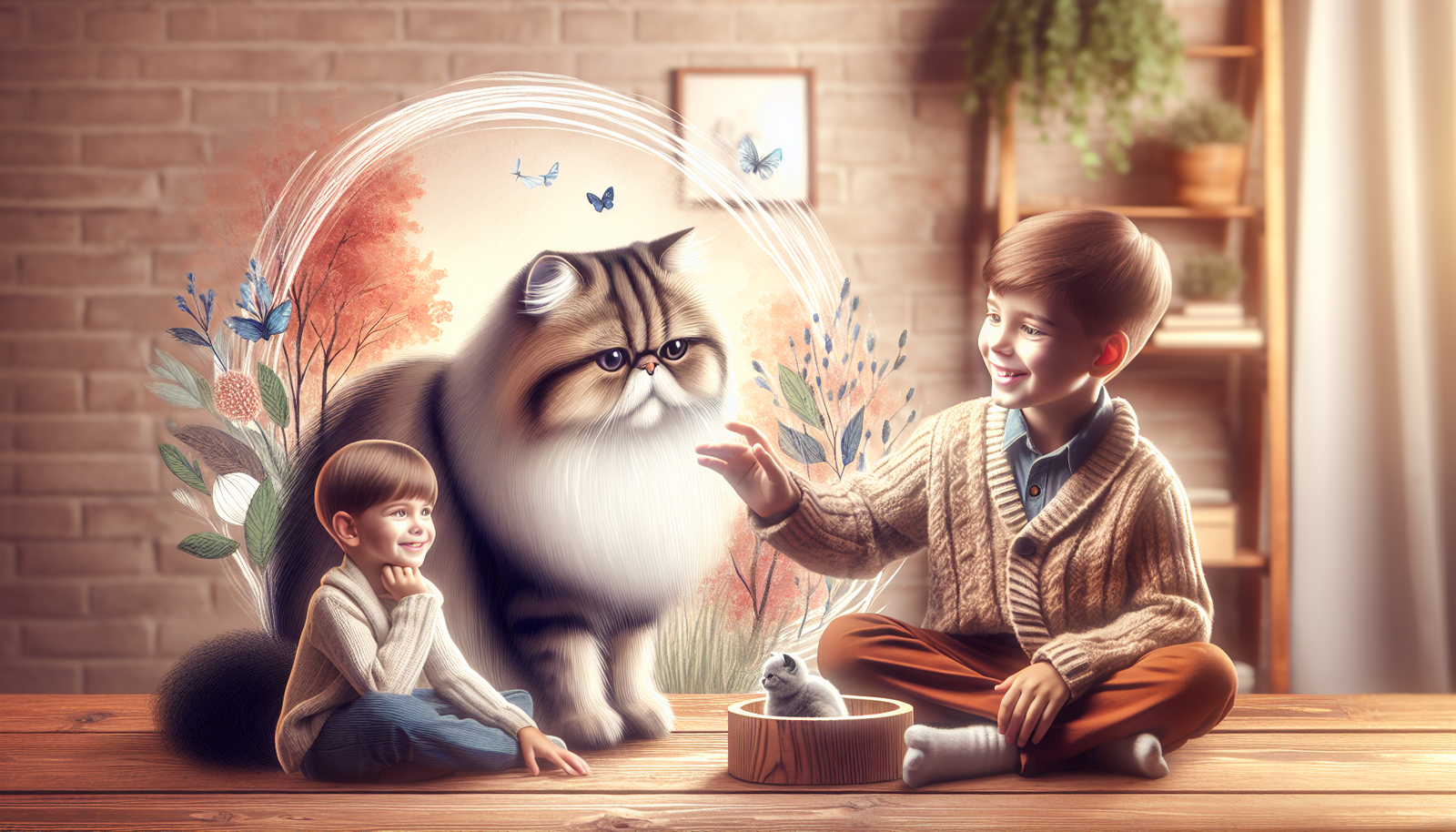Persian Cats, famous for their luxurious coats and gentle demeanor, are often sought after as family pets. But, are they truly kid-friendly? Many parents wonder if these elegant felines will get along well with their little ones. Whether you have toddlers or older children, it’s essential to consider the temperament and characteristics of Persian Cats before bringing one into your home. In this article, we will explore the compatibility between Persian Cats and children, shedding light on whether they make for a harmonious and safe companionship.
Are Persian Cats Kid-Friendly?
When it comes to choosing a family pet, it’s important to consider the temperament and compatibility of the breed with children. Persian cats are known for their luxurious coats and sweet faces, but are they a good match for kids? In this article, we will explore the unique characteristics of Persian cats, discuss their personality traits, and delve into the considerations and benefits of having a Persian cat in a household with children.
Understanding the Persian Cat Breed
Before we determine if Persian cats are kid-friendly, let’s take a closer look at this beloved breed. Originating from Persia (modern-day Iran), Persian cats have a rich history and are one of the oldest cat breeds in the world. They are famous for their long, flowing coats, short legs, and round faces, creating a distinctive and elegant appearance.
Personality Traits of Persian Cats
Persian cats are renowned for their gentle and calm nature. They tend to have a reserved demeanor and may be initially cautious around new people or situations. However, once they feel comfortable, they are incredibly affectionate and loyal companions. Despite their independent streak, Persian cats rely on human company and enjoy being part of a loving family.
While Persian cats are known for their tendency towards laziness, they still require opportunities for play and exercise to keep them healthy and happy. Additionally, their sensitivity to loud noises should be taken into account, as sudden noises may startle or stress them.
One notable trait of Persian cats is their adaptability to different environments. Whether living in a small apartment or a spacious house, these cats can adjust well as long as they have a safe and comfortable environment.
When it comes to their tolerance towards children, Persian cats generally fare well. They are patient and tolerant, making them suitable companions for kids of all ages. However, as with any interaction between pets and children, proper education and supervision are crucial.

Caring for Persian Cats
Like all pets, Persian cats require proper care to thrive. Here are some important aspects to consider when caring for a Persian cat in a household with children.
Maintaining the exquisite coat of a Persian cat calls for regular grooming. Their long, thick hair is prone to matting, so daily brushing is essential to keep it tangle-free. Additionally, frequent bathing and occasional trimming are necessary to ensure the coat stays clean and in good condition.
Proper nutrition is vital for the overall health of Persian cats. Providing them with a balanced diet that meets their specific nutritional requirements is key. Consult with a veterinarian to determine the best diet plan for your Persian cat and ensure that fresh water is always available.
Regular veterinary check-ups are essential to ensure the well-being of your furry friend. Persian cats may be prone to certain health issues, including respiratory problems, eye conditions, and dental problems. Routine examinations and preventive care can help detect and manage any potential health concerns.
While Persian cats may not require as much exercise as some other breeds, they still need opportunities to play and stay active. Engaging them in interactive play sessions, providing toys, and creating climbing or scratching areas are all ways to keep them mentally and physically stimulated.
Creating a safe and comfortable environment for your Persian cat is essential. Ensure that your home is free from hazards such as toxic plants or small objects that could be swallowed. Provide cozy sleeping areas and designated scratching posts to satisfy their natural instincts.
Taking preventive measures to maintain your Persian cat’s health is crucial. Regular flea and tick prevention treatments, as well as vaccinations, should be part of their care routine. It’s also important to be mindful of any potential allergies your family members may have towards cats, as Persian cats are not hypoallergenic.
Teaching Kids How to Interact with Persian Cats
When introducing a Persian cat to your family, it’s important to educate your children on how to interact with them appropriately. Teaching gentle touch and proper handling is essential to ensure the well-being of both the cat and the child.
Supervision and setting boundaries are important aspects of ensuring safe interactions between kids and Persian cats. Teaching your children to respect the cat’s personal space and not to disturb them while they eat or sleep is crucial.
Educating kids about cat behavior can help them understand their new furry friend better. Explaining how cats communicate through body language and vocalization can promote a deeper bond and prevent misunderstandings.
Encouraging play and bonding between kids and Persian cats can be a wonderful experience. Interactive toys and engaging in gentle play sessions can help foster a positive relationship and create lasting memories.

Safety Tips for Kids and Persian Cats
To ensure the safety of both children and Persian cats, it’s important to establish some guidelines and safety measures.
Rough play should be avoided when interacting with Persian cats. Teach your children the importance of gentle play and discourage any behavior that could potentially harm or stress the cat, such as pulling their tail or ears.
Proper hygiene is crucial when handling pets. Teach your children to wash their hands before and after handling the Persian cat to prevent the spread of bacteria or potential illness.
Children with allergies should take extra precautions when interacting with Persian cats. Regular grooming and keeping the environment clean can help minimize allergens, but it’s important to consult with a healthcare professional if allergies persist.
Supervision is key when children and Persian cats interact. Adults should always be present during playtime and interactions to ensure the safety of both parties.
Establishing rules and boundaries is important for a harmonious household. Teach your children to respect the Persian cat’s personal space and communicate any concerns they may have to an adult.
Be mindful of warning signs that may indicate the cat is feeling stressed or uncomfortable. Rapid tail movements, hissing, or attempts to hide should be taken as cues to give the cat some space.
Teaching respect for animals is a valuable life lesson. Encourage your children to treat the Persian cat with kindness and empathy, fostering a loving and compassionate attitude towards all living creatures.
Potential Allergies and Health Concerns
While Persian cats are not hypoallergenic, there are ways to minimize allergies in households with allergic individuals. Regular grooming, including bathing and brushing, can help reduce dander and allergens. Additionally, keeping the house clean and well-ventilated can provide relief for those with allergies.
It’s important to be aware of common health issues that Persian cats may be prone to. Respiratory problems, eye conditions, such as cherry eye or tear duct issues, and dental problems are some of the health concerns to monitor. Regular veterinary check-ups and prompt attention to any signs of illness are crucial for maintaining their well-being.
In case of any health concerns, it’s always best to consult with a veterinarian who can provide specific guidance and advice tailored to the needs of your Persian cat.
Benefits of Persian Cats for Kids
Despite the considerations and precautions, having a Persian cat can bring numerous benefits to a household with children.
Companionship and emotional support are among the greatest benefits a Persian cat can offer. Their gentle and calm nature soothes and comforts, providing a loving presence in times of need.
Being responsible for the care of a Persian cat can teach children valuable life lessons. From feeding and grooming to understanding the importance of routine veterinary visits, kids learn about responsibility, empathy, and nurturing.
Having a Persian cat can also improve children’s social skills. Cats can serve as a topic of conversation and a catalyst for building friendships. Caring for a pet can also teach children about empathy, compassion, and the importance of considering others’ needs.
Pets, including Persian cats, have been known to reduce stress and anxiety. The simple act of petting a cat can release endorphins and create a sense of calm. This can be especially beneficial for children who may be dealing with stress or anxiety.
Cats are natural comforters, and a Persian cat can provide a sense of relaxation and tranquility in a chaotic world. Curling up with a cat can be a source of comfort and a calming presence for children.
Having a Persian cat in the household can enhance learning and cognitive development. Children can learn about the cat’s behavior, body language, and needs, fostering a curiosity and love for animals. This knowledge can contribute to their overall cognitive growth.
Considerations for Families with Kids and Persian Cats
Before bringing a Persian cat into a household with children, there are a few important considerations to keep in mind.
Caring for a Persian cat requires time and effort. Their luxurious coats and specific grooming needs demand regular attention. Ensure that your family is ready to commit to the care and maintenance of a Persian cat.
Financial responsibilities should also be taken into consideration. The cost of food, grooming supplies, veterinary care, and potential unexpected expenses should be budgeted for to ensure the cat’s well-being.
Space and allergen considerations are important factors in determining if a Persian cat is suitable for your family. Ensure that there is enough space in your home for the cat to move freely and that no family members have severe allergies that would be exacerbated by having a Persian cat.
Consider the compatibility of a Persian cat with your family dynamics. Some Persian cats may have a more reserved nature and may not appreciate excessive noise or commotion. Evaluate whether your family’s activity level and energy align with the needs and temperament of a Persian cat.
If you have other pets in the household, it’s important to consider their compatibility with a Persian cat. Introducing a new pet to the mix should be done gradually and with caution to ensure the well-being of all animals involved.
Introducing a Persian Cat to the Family
When bringing a Persian cat into a household with children, it’s important to take the necessary steps to ensure a smooth transition.
Provide a safe and comfortable space for the Persian cat to call its own. Set up a cozy bed, litter box, and scratching post in a quiet area of the house where the cat can retreat to when in need of solitude.
Introduce the cat slowly to the other family members, including children. Encourage calm and gentle interactions, keeping a watchful eye on the cat’s body language and the children’s behavior.
Allow the cat to approach and initiate contact with the children when it feels comfortable. Be patient and understanding, as each cat may take a different amount of time to adjust to their new environment.
Supervise all interactions between children and the Persian cat, especially in the beginning. Ensure that the interactions are positive and stress-free for both parties involved.
By following these guidelines, you can create a safe and loving environment for your Persian cat and your children, fostering a bond that will grow stronger over time.
Conclusion
In conclusion, Persian cats can indeed be kid-friendly companions. Their gentle and calm nature, paired with their affectionate and loyal personality, make them suitable for households with children. By providing proper care, education, and respect for both the cat and the child, a Persian cat can bring joy, companionship, and numerous benefits to a family. However, it’s crucial to consider the specific needs of the breed, the care requirements, and the dynamics of your own family before making the decision to invite a Persian cat into your home. With love, care, and patience, a Persian cat can become an invaluable and cherished member of your family.

